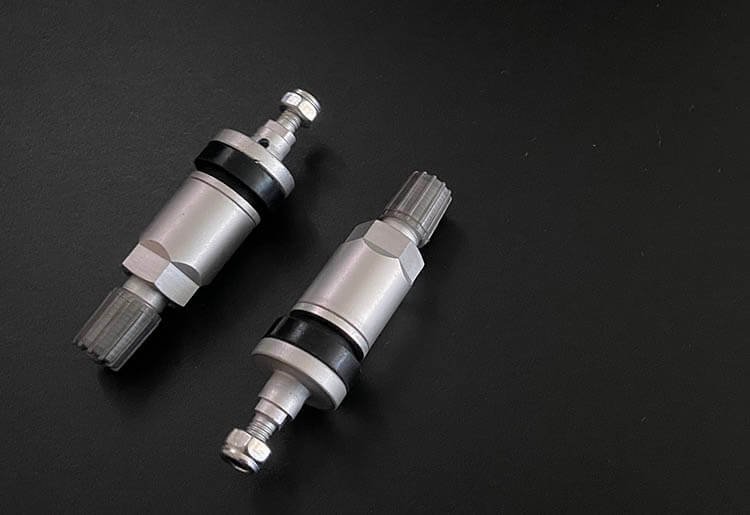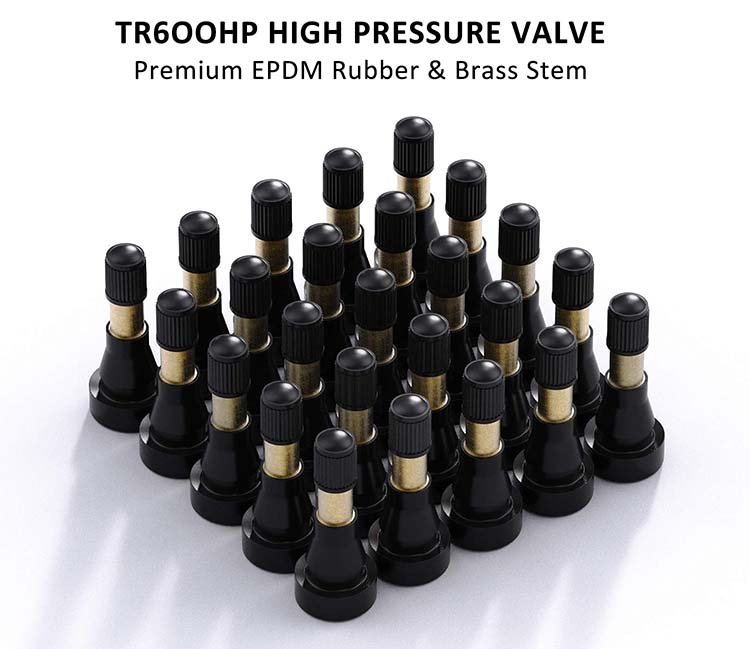What are the different types of tire valves?
There are three basic types of car tire valves: rubber tire valves, metal tire valves and TPMS valves.
1. Rubber tire valves
The main part of the rubber valve is made of rubber material. It usually includes a valve body, a valve core and a valve cap. The valve body is made of rubber, which is relatively soft and elastic. One end of the valve is connected to the inside of the tire, and the other end is used to install the valve core. The structure and working principle of the valve core are similar to those of the valve core in other valves. It is a one-way valve that controls the inlet and outlet of gas. The valve cap is generally made of plastic and is used to protect the valve core and prevent dust, water and other impurities from entering.
Advantages of rubber tire valves:
The cost of rubber valves is low, which makes it widely used in many economical car tires and some small vehicle tires. It has good elasticity and can adapt to the deformation and vibration of the tire during driving to a certain extent, reduce the stress on the root of the valve, and reduce the risk of damage. Moreover, the installation of rubber valves is relatively simple and does not require complicated processes and tools.
Disadvantages of rubber tire valves:
The aging resistance of rubber valves is relatively poor. During long-term use, rubber will be affected by ultraviolet rays, ozone, high temperature and other factors and gradually age, harden, and even crack. This will cause the sealing performance of the valve to deteriorate and leak. Its service life is generally shorter than that of metal valves. In addition, the pressure resistance of rubber valves is limited. In high-pressure or high-load tire application scenarios, they may be deformed too much and damaged.
Application scenarios of rubber valves:
Mainly used in tires of some small cars, motorcycles, bicycles, etc., especially for those vehicles that are more cost-sensitive and do not require particularly high tire pressure. For example, many economical family cars use rubber valves in their tires.
2. Metal tire valve
Metal tire valve structural features:
Metal tire valves are generally made of metal materials such as brass or stainless steel. Its structure also includes a valve body, a valve core and a valve cap. The valve body is made of metal, which is durable and has some anti-rust treatment on its surface. The design and working principle of the valve core are the same as those of the valve core in the rubber tire valve, and it is a key component for controlling the inlet and outlet of gas. The valve cap can be made of metal or plastic, and is mainly used to protect the valve core.
Metal tire valve advantages:
Metal tire valves have excellent aging resistance. Since the metal material itself is not easily affected by ultraviolet rays, ozone and other factors, it has a long service life. It has strong pressure resistance and can withstand higher tire pressure, which is suitable for some high-pressure, high-performance tire application scenarios. Moreover, the appearance of the metal tire valve is more beautiful, and some high-end car brands will choose metal tire valves to enhance the overall texture of the vehicle.
Metal tire valve disadvantages:
The cost of metal tire valves is relatively high, which limits its application in some economical vehicle tires. Its elasticity is not as good as that of rubber valves. When the tire is greatly deformed, the metal valve may cause certain local stress concentration on the tire. However, this situation can be alleviated with the cooperation of reasonably designed tires and valves.
Application scenarios of metal tire valves:
Widely used in tires of various high-end cars, heavy trucks, high-performance sports cars, etc. For example, tires of luxury brand cars such as Mercedes-Benz and BMW usually use metal valves to ensure high performance and long life of the tires. At the same time, on some high-load commercial vehicle tires, metal valves can also play the advantage of strong pressure resistance.
3.TPMS tire valve (tire pressure monitoring system valve)

TPMS tire valve structural features:
TPMS tire valve integrates tire pressure monitoring function on the basis of traditional tire valve. Its appearance is similar to ordinary tire valve, but it has tire pressure monitoring sensor inside or outside. The internal integrated TPMS tire valve sensor is usually installed near the valve core and transmits tire pressure data through wireless signals; the external integrated TPMS tire valve sensor is installed outside the valve, usually an independent small device, and also transmits data through wireless signals. The material of the valve itself can be rubber or metal, depending on the requirements of the vehicle tire.
TPMS tire valve advantages:
The biggest advantage of TPMS tire valve is that it can monitor tire pressure and temperature in real time and transmit these data to the vehicle's electronic control system. This is very important for improving vehicle driving safety. The driver can detect abnormal conditions of the tire in time, such as insufficient air pressure, excessive air pressure or abnormal temperature, and take corresponding measures. It is an important manifestation of the intelligence of modern cars.
Disadvantages of TPMS valves:
TPMS valves cost more than ordinary valves because they contain tire pressure monitoring sensors and related electronic components. Moreover, their installation and maintenance are relatively complicated, requiring professional equipment and technology to ensure the normal operation of the tire pressure monitoring system. If the sensor fails, it may cause incorrect tire pressure information or fail to obtain tire pressure information.
TPMS valve application scenarios:
It is widely used in most modern mid-to-high-end cars and some special vehicles. For example, many sedans and SUV models are equipped with tires with TPMS valves to improve driving safety.


